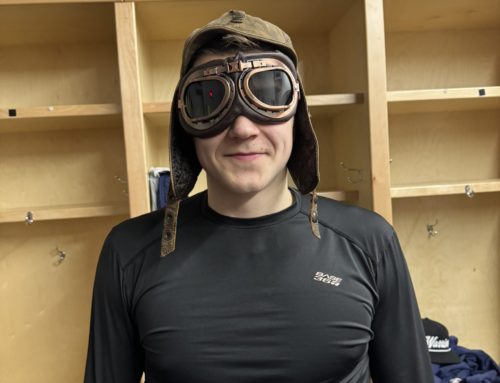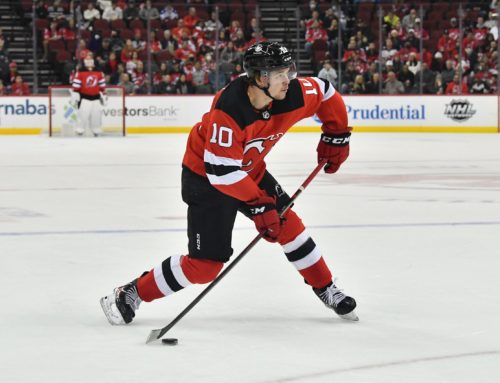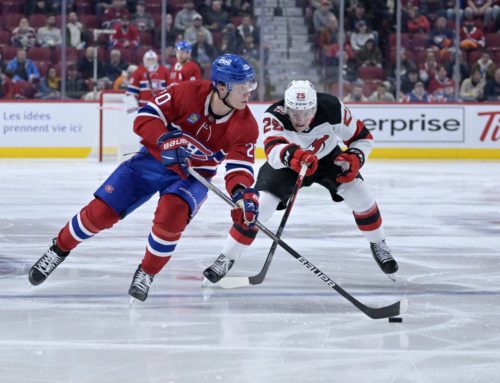Century Mark: Revisiting Predictions from Two Years Ago on Cozens, Smith, Brannstrom, Sandin, Drysdale, and Bean
Ben Gehrels
2023-10-25
Two seasons ago, I wrote the first Century Mark column, and we are currently sharpening the blades of the third go-around. Now is the perfect time to check in and see how things went for the fellas who were covered in the initial year.
But first, a quick backstory: I got back into fantasy hockey after many years away upon learning of keeper leagues, having spent a decade or so signing up for as many Yahoo! Redrafts as one could. I was first brought back into the fold by a friend of mine who had a long-standing keeper league with his friends. The concept of building a team to be competitive for the long haul, perennially, versus just sprinting to the end of a Roto or Head to Head race just to start from scratch next year felt so much more satisfying. As with any manager in a Keeper/Dynasty league, the offseason was always fraught with tough decisions. Which players do I invest limited keeper space into, and most importantly, who is worthy of the prospect roster space.
After drafting a player, justifying keeping him on your farm roster while he matures, keeping tabs as he hits the AHL, and watching him take shifts in the NHL, once his first season is in the books, the tough decisions begin. Most leagues have an 82 or 100 game limit for managers to keep their players on the ‘farm team’ before having to call him up to the big leagues or release him into the wild. When a rookie is “too old” to keep on the farm list, but isn’t producing at his ceiling yet, devoting a main roster spot runs the risk of lowering your team’s output while he grows into himself.
This game within a game reignited my love for fantasy hockey, introduced me to the prospect game as well as a whole new world that I quickly found myself somewhat lost in. As my friend and I discovered our shared passion for unearthing diamonds in the rough while they were still looked at as fringe prospects, our conversations were dominated by discussing the tools at one’s disposal to try to gauge a prospect’s future value.
I listened to Jesse Severe and Victor Nuno’s Fantasy Hockey Life podcast, downloaded the Rank King app, signed up for Byron Bader’s Hockey Prospecting site, among other troves of information. I perused Dobber’s Frozen Tools, scrolled through tweets, and anything else I could get my hands on. One thing that I found frustrating, however, is that there was not only an abundance of information, but so much of that information was presented in a way that felt like the target audience was those who already knew and understood this world. I, just stepping out of the wilderness all squint-eyed and confused, felt that I was watching this rush hour of information traffic whizzing by and I could not keep up.
I bemoaned this to my friends and a few discord channels and league chats I was in, trying to find any accessible, friendly contact to translate all the abbreviations and “turkey charts” I saw posted, void of the necessary context I required, until one day someone suggested I create one myself.
A few chats with the crew at Dobber Prospects later, the Century Mark was born.
My goal is, was, and always will be, to help new folks to the world of prospectery and dataism find digestible nuggets, laden with explanation and context clues, to help you build your confidence at understanding the information available to you. I’ll use some of the powerful tools, like those mentioned above, to build your understanding of what to look at, and how to add to your war chest of information as you try to build better squads than your pals, opponents, and colleagues in your leagues.
There’s no shortage of podcasts, twitter feeds, youtube channels and websites who will perhaps give you a stronger take on the specific ceiling of some of the players I’ll mention, or give more qualitative info on the skating speed, shot accuracy, and angle of a player’s hips in his skating stride. With the Century Mark, my intent is less to give you those fish, and instead give you the bait, and teach you how to use the spinners that are readily available to you, in the hopes that by making the data more accessible, you can build your own acumen, and use it to build your own teams.
It’s more enjoyable for me to write, and hopefully for you to read, and in the long run, will lead to you feeling more empowered and involved in your own decisions for your team’s future.
Now with all those warm and fuzzies out of the way, let’s get to the cold hard data and see how I fared in year one.
Dylan Cozens (BUF)
Cozens was the very first player I chose for the Century Mark, and he has been an interesting player to watch since then. He was just starting to make his mark on the Sabres, getting a lion’s share of the offensive deployment, and was not being sheltered versus weak competition. Those points, as well as a strong point pace (40 points per 82), his W eligibility at the time making his FOW all the more valuable, led me giving the advice to keep him. I also suggested one could trade him for a playoff tilting player at another position based on your league’s depth or settings, though given the variability of leagues out there, I’ll tend to leave that type of comment out going forward, and just make a ‘keep or cut’ recommendation as realistically, anyone can be traded.
Today’s verdict:
Cozens has been worth keeping on the pro roster since the column dropped in March of 2022. His 2023 season was a coming out party, where he scored 31 goals and 37 assists in 81 games, and 18 of those points came on the powerplay. He upped his shots per game to 2.5 and finished with 567 faceoff wins. Buffalo is a team on the rise, and Cozens centered Jack Quinn and JJ Peterka for the near entirety of that season, while playing on the top power play. Though Tage Thompson is likely the big man on campus in more ways than one, Cozens will continue to provide solid value as a top six forward, with power play time on a team on the upswing, and remains a solid keep going forward.
Ty Smith (PIT)
Ty Smith really was the catalyst for this column. I have always had great interest in offensive defensemen who could quarterback a power play. The VORP (Value Over Replacement Player) on offensive defensemen is palpable in most regular leagues, as we can see quite clearly in the points provided by forwards versus defensemen.
Last season, the 25th highest scoring forward in total points–Brady Tkachuk–had 83. Contrast that to the fact that only one defensemen outpaced that mark at all–Erik Karlsson–and the 25th highest-scoring defenseman was K’Andre Miller with 43. The fact Smith was seeing 20 minutes a night, getting half the power play time, and put up a near 40 point pace as a rookie on a less than stellar, but up-and-coming Devils squad had me enamoured.
I suggested you keep Ty Smith as he worked out the kinks in the AHL, after his sophomore slump led to his demotion.
Today’s Verdict:
I love drafting and stashing high-octane offensive defensemen, but this comes with several inherent risks and issues. Most teams these days run a four forward, one defenseman powerplay, and this allows just one true PPQB on the back end for the entire team, with at best one other relegated to the second powerplay. This increases the value of those who have earned this esteemed position, and who maintain their hold of it, while also placing a strong barrier to entry in front of others who covet it. This minimizes these potential PPQBs who are still cutting their teeth to playing more 5-on-5 minutes, where their potential lack of defensive prowess can be exposed.
The ever-present danger of a player not hitting their ceiling in general aside, defensemen are a different breed. We’ve all heard the adage that “defensemen just take longer to develop”, and with that comes a longer time frame of knowing for certain where a player will ultimately land on the roulette wheel of prospect success. This issue is compounded further with the 100-game threshold where a player must supplant an incumbent keeper on the pro roster if he’s to be kept at the end of the year. In the case of Ty Smith, he’s not doing you any good right now being rostered on your pro squad. He’s occupying a spot that could be providing even replacement level production while providing precisely zero himself. But I also still feel trepidation dropping him for nothing. I’ve done so in a few leagues, and his passing through the waiver wire unclaimed in the NHL has been mirrored in my leagues, but I keep him on my watch list and I’ll be checking his performance in Wilkes-Barre for any signs of heating up at the AHL level.
Erik Brannstrom (OTT)
Another highly touted offensive defensemen in prospect circles around the time I began this column, Brannstrom was a mainstay on all the teams that my friend and I comanage in deeper dynasties. We both wanted to see him become a puck-slinging PPQB on an up and coming Ottawa team, but we were both souring on his usage and deployment, and were on the verge of cutting bait when I wrote about him.
Brannstrom had the makings of a set-up man ready to seed some passes to a potent Senators power play in the making, and his shooting percentage in the NHL was looking ripe for positive regression, but the lack of peripherals, the lack of development and the arrival of Jake Sanderson has pretty much cemented Brannstrom on the low end of his potential at this point.
My advice at the time of the article was to move on. There were then, and most certainly more now, plenty of higher tier offensive defensemen you could keep planted on the farm while Brannstrom’s eligibility expired.
Today’s Verdict:
Brannstrom seems a lock to hit the 200 NHL GP mark, which by Hockey Prospecting’s measure is a success for sure, but managers who invested draft or trade capital while banking on him realizing his offensive upside will be a tad sorry for the investment.
Rasmus Sandin (WAS)
Sandin was one of many NHL-capable defensemen the Leafs had in their AHL stable but seemed compelled to leave in the minors. At the time I wrote the column, he was finally getting the chance to play some meaningful minutes in regular succession but then went down with consecutive knee injuries. His play-driving numbers looked great, he was getting sheltered minutes behind the veterans and making good use of them.
My take was that given the big contract Morgan Rielly was given, he’d likely eat most of Sandin’s choice deployment. Despite that, I felt he was a versatile enough PP2 defenseman that he was worth keeping as a depth option, unless you could trade him for a ~50 point defender back.
Today’s Verdict:
The Leafs ultimately traded Sandin after he reportedly was less than pleased with his utilization, not that one could blame him. After being moved to Washington, he played with a chip on his shoulder, scoring 15 points in 19 games, making the most of the deployment he saw with John Carlson out for the year. With Carlson back now, and the Washington juggernaut now somewhat of a defanged destroyer limping into the bay, Sandin has less choice deployment going forward than that storybook end to last season, but remains a decent depth play in deeper leagues.
Jamie Drysdale (ANA)
Clearly, my penchant for high-offensive-ceiling defensemen is palpable at this point. Drysdale is likely the most highly touted defenseman on this list, both two years ago when the initial article was written, and today. Between his initial write up and now, Drysdale played eight games in 2022-2023, before being injured and missing the rest of the season. His lack of play time makes him a harder quantitative read, potentially insulating his value- one can’t underperform while on the IR!- but also causing some managers to downgrade his value, as recency bias settles in.
My initial take on Drysdale was to keep him, as he has offensive pedigree, and the defensive floor to stick around a long time. I mentioned hedging your bets and getting in on Olen Zellweger if you could, as if he continued his growth, it wasn’t impossible to see him usurp Drysdale on PP1. Since then, Zellweger has proven he’s the real deal offensively, and a dynamo by the name of Pavel Mintyukov has been added to the prospect stable, and is doing well with the minutes he is seeing today. There could still end up being a world where Drysdale gets more 5 on 5 minutes and one of Zellweger/Mintyukov gets the choice power play deployment.
Today’s verdict:
Obvious keep. Your best chance to have scooped up Drysdale would have been last year prior to keeper selection when he missed the majority of the season. Now that managers have held him through cuts, and he’s back on the ice, leaning on Mintyukov’s start to the season and Zellweger’s AHL start as a way to sow some doubt may be your only option. It wouldn’t be surprising to see Mintyukov get sent down at some point and Zellweger get his chance to showcase himself in the NHL, and if you plant that seed now, you could weasel your way back in if it comes to fruition.
Jake Bean (CBJ)
Bean’s was a name many had on their “just off of everyone else’s radar” radar as he made his way towards the NHL. With just about a point per game in his WHL career and two AHL seasons where he put up 92 points in 122 games, poolies watched him leave the log jam in Carolina, be passed over by Seattle in the Expansion draft- though who wasn’t passed over in that draft- and ultimately end up in what was supposedly a better spot in Columbus.
My advice on Bean at the time of writing was to move on. You’d have had a hard enough time keeping him over the other defensive prospects out there, and new draftees quickly began to usurp him as a prospect asset.
Today’s Verdict:
Much like Adam Boqvist, Bean as of today’s writing has done very little to reward those that have kept him on their squads- and as he is currently 35% rostered on Fantrax, that club is likely quite exclusive- both with being injured more often than not, and not performing much when healthy. Add to that the growing log jam on defense in Columbus with David Jiricek, Denton Mateychuk and in the neighbourhood of fifteen veteran defensemen brought in this off season, Bean’s future fantasy value is as murky as ever.
****
Thank you to everyone who has read my articles for the last two seasons. I hope they’ve been interesting and entertaining, and have provided you some food for thought as you make your choices. I look forward to another season of diving into the data behind some of the players who will break the century mark this season, and helping you expand your assessment tool box as you tinker with your squads.
See you out on the fantasy ice.






